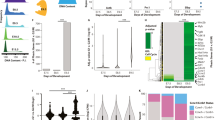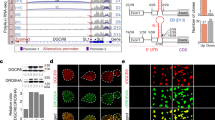Abstract
miRNA populations, including mammalian homologues of lin-4 (mir-125) and let-7, undergo a marked transition during stem-cell differentiation1. Originally identified on the basis of their mutational phenotypes in stem-cell maturation, mir-125 and let-7 are strongly induced during neural differentiation of embryonic stem (ES) cells and embryocarcinoma (EC) cells. We report that embryonic neural stem (NS) cells express let-7 and mir-125, and investigate post-transcriptional mechanisms contributing to the induction of let-7. We demonstrate that the pluripotency factor Lin-28 binds the pre-let-7 RNA and inhibits processing by the Dicer ribonuclease in ES and EC cells. In NS cells, Lin-28 is downregulated by mir-125 and let-7, allowing processing of pre-let-7 to proceed. Suppression of let-7 or mir-125 activity in NS cells led to upregulation of Lin-28 and loss of pre-let-7 processing activity, suggesting that let-7, mir-125 and lin-28 participate in an autoregulatory circuit that controls miRNA processing during NS-cell commitment.
This is a preview of subscription content, access via your institution
Access options
Subscribe to this journal
Receive 12 print issues and online access
$209.00 per year
only $17.42 per issue
Buy this article
- Purchase on Springer Link
- Instant access to full article PDF
Prices may be subject to local taxes which are calculated during checkout





Similar content being viewed by others
References
Houbaviy, H. B., Murray, M. F. & Sharp, P. A. Embryonic stem cell-specific microRNAs. Dev. Cell 5, 351–358 (2003).
Arasu, P., Wightman, B. & Ruvkun, G. Temporal regulation of lin-14 by the antagonistic action of two other heterochronic genes, lin-4 and lin-28. Genes Dev. 5, 1825–1833 (1991).
Lee, R. C., Feinbaum, R. L. & Ambros, V. The C. elegans heterochronic gene lin-4 encodes small RNAs with antisense complementarity to lin-14. Cell 75, 843–854 (1993).
Wightman, B., Ha, I. & Ruvkun, G. Posttranscriptional regulation of the heterochronic gene lin-14 by lin- 4 mediates temporal pattern formation in C. elegans. Cell 75, 855–862 (1993).
Pasquinelli, A. E. et al. Conservation of the sequence and temporal expression of let-7 heterochronic regulatory RNA. Nature 408, 86–89 (2000).
Reinhart, B. J. et al. The 21-nucleotide let-7 RNA regulates developmental timing in Caenorhabditis elegans. Nature 403, 901–906 (2000).
Ambros, V. Control of developmental timing in Caenorhabditis elegans. Curr. Opin. Genet. Dev. 10, 428–433 (2000).
Lagos-Quintana, M. et al. Identification of tissue-specific microRNAs from mouse. Curr. Biol. 12, 735–739 (2002).
Wu, L. & Belasco, J. G. Micro-RNA regulation of the mammalian lin-28 gene during neuronal differentiation of embryonal carcinoma cells. Mol. Cell Biol. 25, 9198–9208 (2005).
Yu, J. et al. Induced pluripotent stem cell lines derived from human somatic cells. Science 318, 1917–1920 (2007).
Kanamoto, T., Terada, K., Yoshikawa, H. & Furukawa, T. Cloning and regulation of the vertebrate homologue of lin-41 that functions as a heterochronic gene in Caenorhabditis elegans. Dev. Dyn. 235, 1142–1149 (2006).
Ibarra, I., Erlich, Y., Muthuswamy, S. K., Sachidanandam, R. & Hannon, G. J. A role for microRNAs in maintenance of mouse mammary epithelial progenitor cells. Genes Dev. 21, 3238–3243 (2007).
Johnson, S. M. et al. RAS is regulated by the let-7 microRNA family. Cell 120, 635–647 (2005).
Johnson, C. D. et al. The let-7 microRNA represses cell proliferation pathways in human cells. Cancer Res. 67, 7713–7722 (2007).
Young, A. R. & Narita, M. Oncogenic HMGA2: short or small? Genes Dev. 21, 1005–1009 (2007).
Lee, Y., Han, J., Yeom, K. H., Jin, H. & Kim, V. N. Drosha in primary microRNA processing. Cold Spring Harb. Symp. Quant. Biol. 71, 51–57 (2006).
Filipowicz, W., Jaskiewicz, L., Kolb, F. A. & Pillai, R. S. Post-transcriptional gene silencing by siRNAs and miRNAs. Curr. Opin. Struct. Biol. 15, 331–341 (2005).
Hammond, S. M. MicroRNAs as oncogenes. Curr. Opin. Genet. Dev. 16, 4–9 (2006).
Chendrimada, T. P. et al. TRBP recruits the Dicer complex to Ago2 for microRNA processing and gene silencing. Nature (2005).
Thomson, J. M. et al. Extensive post-transcriptional regulation of microRNAs and its implications for cancer. Genes Dev. 20, 2202–2207 (2006).
Viswanathan, S. R., Daley, G. Q. & Gregory, R. I. Selective blockade of microRNA processing by Lin-28. Science 320, 97–100 (2008).
Obernosterer, G., Leuschner, P. J., Alenius, M. & Martinez, J. Post-transcriptional regulation of microRNA expression. RNA 12, 1161–1167 (2006).
Wulczyn, F. G. et al. Post-transcriptional regulation of the let-7 microRNA during neural cell specification. FASEB J. 21, 415–426 (2007).
Makeyev, E. V., Zhang, J., Carrasco, M. A. & Maniatis, T. The microRNA miR-124 promotes neuronal differentiation by triggering brain-specific alternative pre-mRNA splicing. Mol. Cell 27, 435–448 (2007).
Smirnova, L. et al. Regulation of miRNA expression during neural cell specification. Eur. J. Neurosci. 21, 1469–1477 (2005).
Ebert, M. S., Neilson, J. R. & Sharp, P. A. MicroRNA sponges: competitive inhibitors of small RNAs in mammalian cells. Nature Methods 4, 721–726 (2007).
Lee, Y. S., Kim, H. K., Chung, S., Kim, K. S. & Dutta, A. Depletion of human micro-RNA miR-125b reveals that it is critical for the proliferation of differentiated cells but not for the down-regulation of putative targets during differentiation. J. Biol. Chem. 280, 16635–16641 (2005).
Parry, D. H., Xu, J. & Ruvkun, G. A whole-genome RNAi Screen for C. elegans miRNA pathway genes. Curr. Biol. 17, 2013–2022 (2007).
Duchaine, T. F. et al. Functional proteomics reveals the biochemical niche of C. elegans DCR-1 in multiple small-RNA-mediated pathways. Cell 124, 343–354 (2006).
Nelson, P. T., Hatzigeorgiou, A. G. & Mourelatos, Z. miRNP:mRNA association in polyribosomes in a human neuronal cell line. RNA 10, 387–394 (2004).
Balzer, E. & Moss, E. G. Localization of the developmental timing regulator Lin28 to mRNP complexes, P-bodies and stress granules. RNA Biol. 4, 16–25 (2007).
Conti, L. et al. Niche-independent symmetrical self-renewal of a mammalian tissue stem cell. PLoS Biol. 3, e283 (2005).
Tsai, A. & Carstens, R. P. An optimized protocol for protein purification in cultured mammalian cells using a tandem affinity purification approach. Nature Protoc. 1, 2820–2827 (2006).
Acknowledgements
The authors would like to thank all members of the laboratories at the Institute for Cell and Neurobiology for support and cooperation. Brita Scholte and Anja Gräfe provided excellent technical assistance. We received invaluable help from Jutta Schüler with microscopy, from Jens Baron and Gudrun Ahnert-Hilger with densitometric quantification, and from Tina Rosenkrantz with LNA design. We thank Wei Chen and Nikolaus Rajewsky for advice and discussions, James Ari Liebkowsky and Elisa Cuevas for critical reading of the manuscript, and Scott Hammond for communicating unpublished results. L.S. and A.R. were partially supported as fellows of the Humboldt University Graduate Schools, Grant 238: Damage cascades in neurological disorders, and Grant 1123: Learning and Memory, respectively, awarded to R.N. Additional support was provided by SFB grant 665 to F.G.W. and R.N.
Author information
Authors and Affiliations
Corresponding author
Ethics declarations
Competing interests
The authors declare no competing financial interests.
Supplementary information
Supplementary Information
Supplementary Figures S1, S2, S3, S4, S5, S6, S7, S8, S9, S10 and Supplementary Methods (PDF 1370 kb)
Rights and permissions
About this article
Cite this article
Rybak, A., Fuchs, H., Smirnova, L. et al. A feedback loop comprising lin-28 and let-7 controls pre-let-7 maturation during neural stem-cell commitment. Nat Cell Biol 10, 987–993 (2008). https://doi.org/10.1038/ncb1759
Received:
Accepted:
Published:
Issue Date:
DOI: https://doi.org/10.1038/ncb1759



